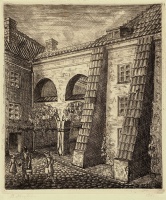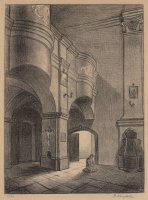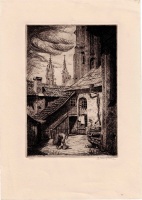

Courtyard of Vilnius University
| Author: | Barbara Narębska–Dębska (1921–2000) |
Barbara Narębska-Dębska (1921–2000) was the daughter of Stefan Narębski, an architect of interwar Vilnius, the restorer of the cathedral, the Bishops’ Palace and other architectural monuments, and a professor at Stephen Báthory University. She was born and grew up in Vilnius, and thanks to her father she became familiar with the city’s cultural heritage. During the Second World War, Narębska-Dębska studied at the Institute of Art in Vilnius, which was later closed down by the Nazis. The Soviets, who replaced the Nazis, put her in Lukiškės gaol, and then deported her to Siberia. When she returned from exile, she moved to Poland and settled in Toruń. She finished her studies at Toruń University, became a graphic artist, and was an active organiser of artistic life. Her style, based on the free interpretation of architectural rhythms, was influenced by her childhood impressions and the old architecture of Vilnius.

Barbara Narębska-Dębska (1921–2000) was the daughter of Stefan Narębski, an architect of interwar Vilnius, the restorer of the cathedral, the Bishops’ Palace and other architectural monuments, and a professor at Stephen Báthory University. She was born and grew up in Vilnius, and thanks to her father she became familiar with the city’s cultural heritage. During the Second World War, Narębska-Dębska studied at the Institute of Art in Vilnius, which was later closed down by the Nazis. The Soviets, who replaced the Nazis, put her in Lukiškės gaol, and then deported her to Siberia. When she returned from exile, she moved to Poland and settled in Toruń. She finished her studies at Toruń University, became a graphic artist, and was an active organiser of artistic life. Her style, based on the free interpretation of architectural rhythms, was influenced by her childhood impressions and the old architecture of Vilnius.








